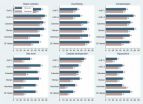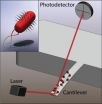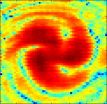(Press-News.org) BOZEMAN, Mont. -- Peak tornado activity in the central and southern Great Plains of the United States is occurring up to two weeks earlier than it did half a century ago, according to a new Montana State University study whose findings could help states in "Tornado Alley" better prepare for these violent storms.
Tornado records from Nebraska, Kansas, Oklahoma, and northern Texas – an area of high tornado activity dubbed "Tornado Alley" -- show that peak tornado activity is starting and ending earlier than it did 60 years ago.
Peak tornado activity, which occurs in the region from early May to early July, has moved an average of seven days earlier in the year over the past six decades. The study's authors, John Long and Paul Stoy in MSU's Department of Land Resources and Environmental Sciences, observed the shift in tornado activity for all categories of tornadoes that occurred in the region from 1954 to 2009.
The research team published its findings last week in Geophysical Research Letters, a journal of the American Geophysical Union.
Additional, more-selective analyses by Long and Stoy show that for some states in the region and for stronger tornadoes the season advances an average of 14 days compared to 1954.
"If we take Nebraska out [of the data], it is nearly a two-week shift earlier," noted Long, a research scientist and lead author of the new paper. For tornadoes rated above F0, the lowest rung on the original Fujita scale of tornado strength, the shift is also close to 14 days, according to a preliminary analysis by Long and his colleagues that's not included in the new paper.
F1 tornadoes have winds between 117 and 180 kilometers per hour (73 and 112 mph), while the strongest tornadoes, F5, have winds between 420 and 511 kilometers per hour (261 and 318 mph), according to the original Fujita scale. Although the Fujita scale was updated in 2007, Long and his colleagues stayed with the original Fujita scale because most data in this new study originates from prior years.
The new research does not attribute the shift in tornado activity in the region to any single cause. However, the earlier tornado activity seen in the study is in line with what could be expected in a warmer climate, the study's authors said.
The new research could help residents in the region be better prepared for severe weather, Long said. About 1,300 tornadoes hit the U.S. every year, killing an average of 60 people, according to the National Weather Service's Storm Prediction Center. This year, the majority of the 309 tornadoes that have hit the U.S. occurred in May and the deadliest storms were in April, according to the Storm Prediction Center.
"From a public safety perspective, if this trend (of an earlier tornado season) is indeed occurring, then people need to begin preparing for severe weather earlier in the year," said Greg Carbin, the warning coordination meteorologist at the Storm Prediction Center in Norman, Okla., who was not involved in the new study.
Long said his interest in tornado timing was sparked by the strong tornado that hit Branson, Mo., in late February 2012. A native of Missouri, Long said the state isn't officially part of Tornado Alley, but it does experience tornadoes and the February tornado seemed unusually early. After others said the same thing, Long decided to investigate. He conducted his research in his spare time while earning his doctorate at MSU. He now works in the Spatial Sciences Center at MSU.
The new research analyzed National Weather Service tornado data for Tornado Alley from 1954 to 2009. The authors broke the data into 10-year time frames and analyzed how the dates of peak tornado activity changed over time.
The analysis showed the date of peak tornado activity in the region moved earlier at a rate of 1.55 days per decade over the time period studied. In the heart of Tornado Alley, an area with the highest density of tornadoes, peak activity shifted by seven days: from May 26 in the 1950s to May 19 in the early 2000s.
Although there is a consistent movement in the region toward earlier tornado activity, it is difficult to pinpoint a cause, said Stoy, assistant professor at MSU and co-author of the new study. Records of tornado activity in the U.S. only date back to the 1950s, making it difficult to study changing trends in tornado activity.
Furthermore, tornadoes can be influenced by many regional factors, including topography of the land and areas where cooler air meets warm, subtropical air, making it difficult to attribute the shift in the tornado season to any one factor, he said.
Carbin, of the Storm Prediction Center, said a warmer climate might play a role. "If winters are not as cold, or if spring times are warmer, the location of the jet stream is most likely displaced north of where it has been in the past," he said.
This would cause tornado activity to shift earlier in the year, like what is seen in the new study, Carbin said.
The study has revealed a connection between one global climate pattern and tornado activity, specifically in the state of Oklahoma. When El Niño conditions occur between January and April, peak tornado activity in Oklahoma occurs earlier in the spring, the researchers report. El Niño, an oscillation of the ocean-atmosphere system that is associated with warm ocean waters in the Pacific Ocean, changes the air surface pressure and atmospheric circulation.
"The relationship we do see in Oklahoma is a light but significant connection to El Niño," Stoy said. "This makes one suspect that if global climate change is changing these larger circulations, then there is a connection between a global [variability] and tornado activity."
INFORMATION:
New research shows tornadoes occurring earlier in 'Tornado Alley'
2014-09-16
ELSE PRESS RELEASES FROM THIS DATE:
Long-term results of RTOG 0236 confirm good primary tumor control, positive 5-year survival rates
2014-09-16
San Francisco, September 15, 2014—Patients with inoperable, early-stage lung cancer who receive stereotactic body radiation therapy (SBRT) have a five-year survival rate of 40 percent, according to research presented today at the American Society for Radiation Oncology's (ASTRO's) 56th Annual Meeting. Such a positive survival rate is encouraging considering that historically conventional RT resulted in poor tumor control for patients with inoperable lung cancer. This study is an update of RTOG 0236, originally published in 2010 , and also conducted by the original researchers ...
Politics divide coastal residents' views of environment, UNH research finds
2014-09-16
DURHAM, N.H. – From the salmon-rich waters of Southeast Alaska to the white sand beaches of Florida's Gulf Coast to Downeast Maine's lobster, lumber and tourist towns, coastal residents around the U.S. share a common characteristic: their views about coastal environments divide along political lines. That's a primary finding of a new study by University of New Hampshire sociologists published this month in the journal Society & Natural Resources.
"We found a lot of environment-related differences from place to place to place. Each environment is different so that's just ...
Artworks are people!
2014-09-16
Not all things are created equally. We don't view a Picasso sculpture in the same way we look at a hammer, for example — no matter how fancy the hammer.
The reason? We see the Picasso more as a person than an object, according to new research from the University of Chicago Booth School of Business.
And in some cases, we make distinctions between artworks — say, an exact replica of a piece created by the artist, versus one created by a different artist.
Art, in other words, is an extension of the creator, write Professor Daniel M. Bartels of Chicago Booth, and Professor ...
For electronics beyond silicon, a new contender emerges
2014-09-16
Cambridge, Mass. – September 16, 2014 – Silicon has few serious competitors as the material of choice in the electronics industry. Yet transistors, the switchable valves that control the flow of electrons in a circuit, cannot simply keep shrinking to meet the needs of powerful, compact devices; physical limitations like energy consumption and heat dissipation are too significant.
Now, using a quantum material called a correlated oxide, Harvard researchers have achieved a reversible change in electrical resistance of eight orders of magnitude, a result the researchers ...
NASA's Global Hawk and satellites investigating Hurricane Edouard today
2014-09-16
The unmanned Global Hawk aircraft that's part of NASA's airborne Hurricane and Severe Storm Sentinel, or HS3 mission was winging its way to Hurricane Edouard on September 16. In addition to the Global Hawk, various NASA satellites are continually providing data on the Atlantic hurricane.
Scientific instruments aboard NASA's remotely piloted Global Hawk aircraft have been studying the hurricane over the last couple of days, and the Global Hawk returned to Edouard again today, September 16. Two of the instruments aboard the Global Hawk that will study Edouard are the S-HIS ...
Cancer patients with malignant spinal cord compression have preserved mobility
2014-09-16
San Francisco, September 15, 2014—Mobility is equally preserved in cancer patients suffering from malignant spinal cord compression (MSCC) who receive a single dose of 10 Gy of radiation therapy (RT), compared to patients who receive five daily doses of 4 Gy of RT each, according to research presented today at the American Society for Radiation Oncology's (ASTRO's) 56th Annual Meeting.
Malignant spinal cord compression (MSCC) is a complication of metastatic cancer mostly with bone involvement that occurs when a tumor's secondary deposit presses on the spinal cord and ...
And so they beat on, flagella against the cantilever
2014-09-16
WASHINGTON D.C., September 16, 2014 – A team of researchers at Boston University and Stanford University School of Medicine has developed a new model to study the motion patterns of bacteria in real time and to determine how these motions relate to communication within a bacterial colony.
The researchers chemically attached colonies of Escherichia coli bacteria to a microcantilever – a microscopic beam anchored at one end, similar to a diving board – thus coupling its motion to that of the bacteria. As the cantilever itself isn't doesn't generate any vibrations, or 'noise,' ...
NASA sees Tropical Storm Odile knocking at US Southwest
2014-09-16
Tropical Storm Odile continues to drench western Mexico and has now entered into the U.S. Southwest. On September 15, NASA's Terra satellite saw Odile's northernmost edge crossing the Mexican border into southern California. NOAA's GOES-East satellite on September 16 showed Odile's outer bands were already bringing storms to southern Arizona.
NASA Sees Odile Knocking on U.S. Border
On Sept. 15 at 2:35 p.m. EDT, the Moderate Resolution Imaging Spectroradiometer instrument aboard NASA's Terra satellite saw the northern fringes of Hurricane Odile straddling the border ...
Scientists twist radio beams to send data
2014-09-16
Building on previous research that twisted light to send data at unheard-of speeds, scientists at USC have developed a similar technique with radiowaves, reaching high speeds without some of the hassles that can go with optical systems.
The researchers, led by electrical engineering professor Alan Willner of the USC Viterbi School of Engineering, reached data transmission rates of 32 gigabits per second across 2.5 meters of free space in a basement lab at USC.
For reference, 32 gigabits per second is fast enough to transmit more than 10 hour-and-a-half-long HD movies ...
Kessler Foundation scientists link slowed processing speed with executive deficits in MS
2014-09-16
West Orange, NJ. September 16, 2014. Kessler Foundation researchers have published a study supporting the role of slowed processing speed in the executive deficits found in individuals with multiple sclerosis (MS). "Does slowed processing speed account for executive deficits in multiple sclerosis? Evidence from neuropsychological performance and structural neuroimaging," was published online ahead of print on August 18 by Rehabilitation Psychology The authors are Victoria Leavitt, PhD, of the Manhattan Memory Center, formerly of Kessler Foundation. Co-authors are Foundation ...





